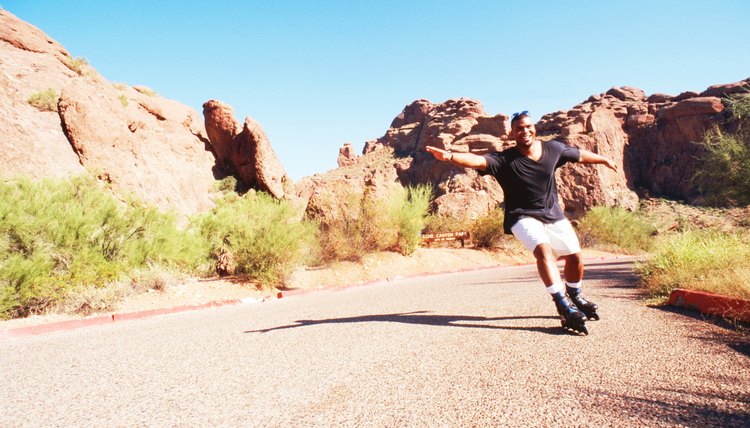How to Slow Rollerblades When Going Downhill

The difference between beginner and intermediate rollerbladers and advanced and experts is the ability to control the speed and direction when descending a hill. If you can slow yourself on a steep grade, with the exception of tricks, you've mastered all there is to master on inline skates. In order to slow down on a hill, you must be able to T-stop. Using your bumpers to slow down is both dangerous and tiring. It's not necessary for you to completely stop every time, but it is necessary for you to use the T-stop as a brake.
Make slalom turns to slow yourself down without braking. Look straight down the hill -- down the fall line -- as you begin accelerating down from the top. Put your hands in front of your hips and bend your knees to between 25 and 50 degrees; the faster you're going, the more you bend your knees. Bend your elbows at the same angle you bend your knees, aligning the fronts of your shoulders, your knees caps and the balls of your feet.
Maintain the position of your balance points -- shoulders, knees, feet -- on the same vertical plane, yet rotate your knees off the straight line to the right or left to begin carving in one direction or the other. Keep looking down the fall line of the hill by keeping your head and shoulders squarely pointed straight down the hill, even though your hips, legs and feet are rotating beneath you on the axis of your spine and torso.
Shift your knees over your feet to the other side of your body to iniate a second turn; it's the change of direction that slows you down; it creates friction between the wheels and the surface of the ground. Though your hips, knees and feet change direction, keep your upper body still and pointed squarely down the fall line. Your knees and feet are moving right to left, but keep them on the same vertical plane as your shoulders.
T-brake after turns using your downhill skate. With your upper body still facing down hill, initiate a turn. Once your knees and skates come around, -- your knees shift to the uphill side of your skates -- move your downhill skate behind you and slightly down hill so that it is at a 45-degree angle to the fall line. Turn your foot so that the wheels on your trailing stake are at a 90-degree angle to the wheels on the uphill skate -- the one you are riding on -- so your skates make an L or a one-armed T.
Drag the wheels across the surface of the ground to create friction and slow yourself. Keep the knee of your uphill skate on the outside of your foot -- uphill from your foot -- to prevent yourself from turning downhill as your brake. Set your trailing foot back beneath your knees, initiate a turn in the other direction, and drag your downhill skate to slow yourself while keeping your uphill knee outside of your uphill skate. Put your foot back beneath you, initiate a turn, and drag your downhill foot. Repeat this process the entire way down the hill.
